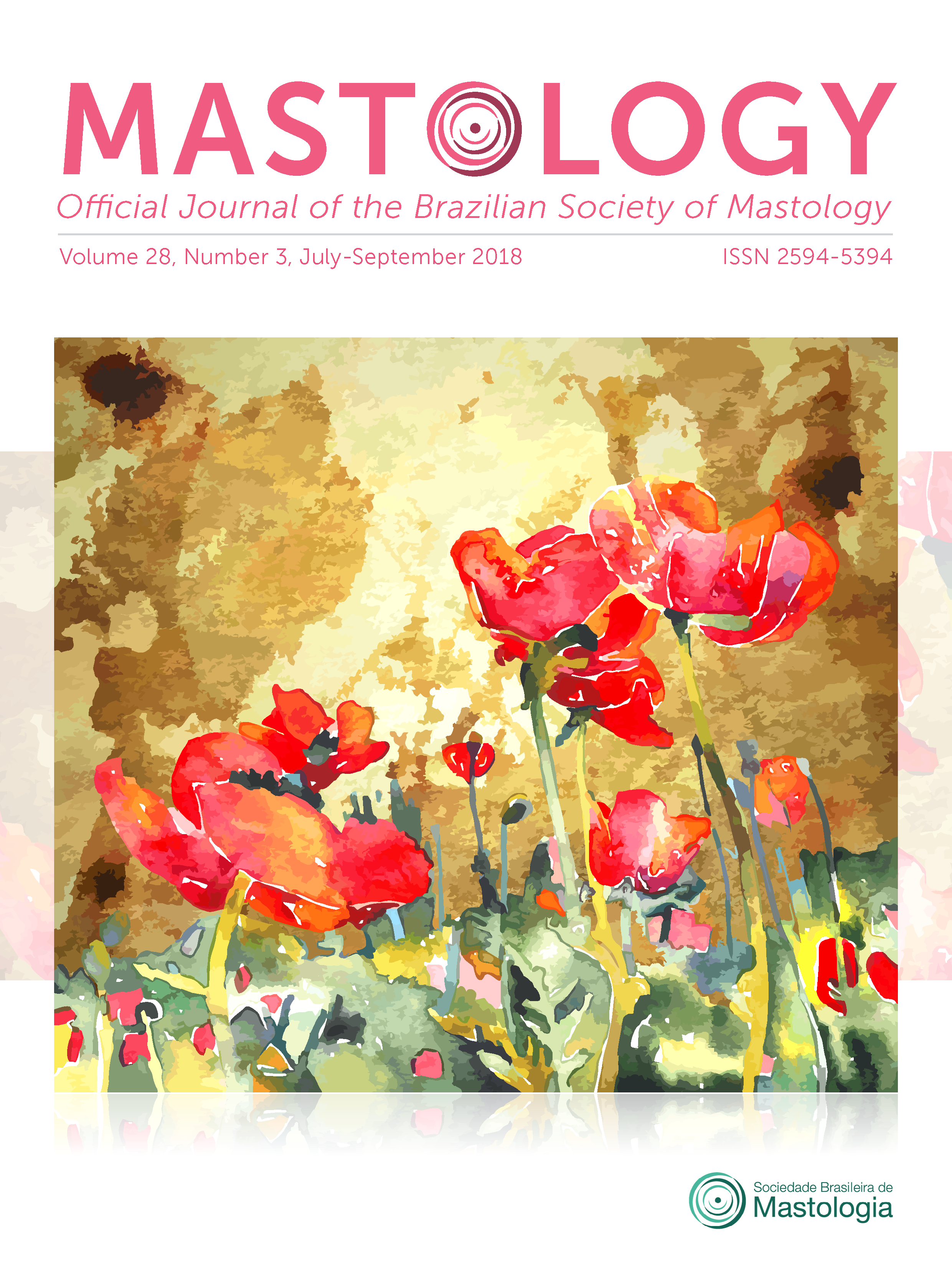GENETIC AND DEMOGRAPHIC FACTORS OF A BRAZILIAN POPULATION SAMPLE AT-RISK OF HEREDITARY BREAST AND OVARIAN CANCER
Keywords:
breast cancer, HBOC syndrome, BRCA1 gene, BRCA2 geneAbstract
Objective: Genetic-related breast cancer has a tendency to manifest earlier and to be more aggressive than sporadic cancer. There are few studies evaluating the prevalence and incidence of hereditary breast and ovarian cancer (HBOC) among Brazilians. In order to improve assistance, efforts to characterize the population at risk of HBOC could help to formulate locally designed guidelines. Methodology: Descriptive retrospective study in Hospital Erasto Gaertner’s service of Oncogenetics, in Curitiba, state of Paraná, Brazil. We included individuals at-risk for HBOC, according to the National Comprehensive Cancer Network (NCCN) criteria, who had performed genetic tests for HBOC. We collected complete family history, presented as heredograms. We excluded families with inappropriate family history. Results: Of the 27 patients analyzed (total of 25 families), 7% were asymptomatic, 8% had ovarian cancer and 85% had breast cancer. Mutations were found in 29.6%, 6 cases of BRCA1, 1 of BRCA2 and 1 of TP53. Triple negative was the most common reported subtype, representing 60% of breast cancers; among patients with identified pathogenic variants, 2 were BRCA2 mutated and 1 TP53 mutated. The mean age of diagnosis was 40 years for those identified as probands on heredograms; in the generation above, it was 52,5, and in the below, 33, suggesting the antecipation phenomena Two new mutations were identified in Brazilian population, both in BRCA1: c.4258 G>A and c.5345 G>A. The most frequent NCCN criteria were number 2, 9, 8 and 4. Estimated penetrance was 22%. Conclusion: This is the first descriptive study in the population at-risk for HBOC in the state of Paraná. We could identify two new pathogenic variants of BRCA1 in Brazilian population. A comprehensive family history was included in the study, depicted as heredograms of each family. Despite the low number of patients, the main results are in agreement with previous studies.
Downloads
References
Instituto Nacional de Câncer José Alencar Gomes da Silva. Estimativa 2016: incidência de câncer no Brasil. Brasil:
Ministério da Saúde/Instituto Nacional de Câncer; 2016.
National Comprehensive Cancer Network. NCCN Clinical Practice Guidelines in Oncology. Pensilvânia: National
Comprehensive Cancer Network; 2016.
Foulkes WD. Inherited susceptibility to common cancers. N Engl J Med. 2008;359(20):2143-53. https://doi.org/10.1056/NEJMra0802968
Chen S, Parmigiani G. Meta-analysis of BRCA1 and BRCA2 penetrance. J Clin Oncol. 2007;25(11):1329-33. https://doi.org/10.1200/JCO.2006.09.1066
Fernandes GC, Michelli RA, Galvão HC, Paula AE, Pereira R, Andrade CE, et al. Prevalence of BRCA1/BRCA2 mutations in a Brazilian population sample at-risk for hereditary breast cancer and characterization of its genetic ancestry. Oncotarget. 2016;7. https://doi.org/10.18632/oncotarget.12610
Landrum MJ, Lee JM, Benson M, Brown GR, Chao C, Chitipiralla S, et al. ClinVar: improving access to variant interpretations and supporting evidence. Nucleic Acids Res. 2018 Jan 4. https://dx.doi.org/10.1093%2Fnar%2Fgkx1153.
Anglian Breast Cancer Study Group. Prevalence and penetrance of BRCA1 and BRCA2 mutations in a populationbased series of breast cancer cases. Anglian Breast Cancer Study Group. Br J Cancer. 2000;83(10):1301-8. https://doi.org/10.1054/bjoc.2000.1407
Petrij-Bosch A, Peelen T, van Vliet M, Eijk RV, Olmer R, Drüsedau M, et al. BRCA1 genomic deletions are major
founder mutations in Dutch breast cancer patients. Nat Genet. 1997;17(3):341-5. https://doi.org/10.1038/ng1197-341
Gomes MCB, Costa MM, Borojevic R, Monteiro ANA, Vieira R, Koifman S, et al. Prevalence of BRCA1 and BRCA2 mutations in breast cancer patients from Brazil. Breast Cancer Res Treat. 2007;103(3):349-53. https://doi.org/10.1007/s10549-006-9378-6
Felix GE, Abe-Sandes C, Machado-Lopes TM, Bomfim TF, Guindalini RSC, Santos VCSAR, et al. Germline mutations in BRCA1, BRCA2, CHEK2 and TP53 in patients at high-risk for HBOC: characterizing a Northeast Brazilian Population. Hum Genome Var. 2014. https://dx.doi.org/10.1038%2Fhgv.2014.12
Sanford RA, Song J, Gutierrez-Barrera AM, Profato J, Woodson A, Litton JK, et al High incidence of germline BRCA mutation in patients with ER low-positiva/PR low-positive/HER-2 neunegative tumors. Cancer. 2015;121(19):3422-7. https://dx.doi.org/10.1002/cncr.29572
Roy R, Chun J, Powell SN. BRCA1 and BRCA2: Differente roles in a common pathway of genome protection. Nat Rev Cancer. 2011;12(1):68-78. https://dx.doi.org/10.1038/nrc3181
Lustbader ED, Williams WR, Bondy ML, Strom S, Strong LC. Segregation analysis of cancer in families of childhood softtissue-sarcoma patients. Am J Jum Genet [Internet]. 1992 [acessado em 1º dez. 2016];51(2):344-56. Disponível em: http://www.ncbi.nlm.nih.gov/pubmed/1642235
Petrucelli N, Daly MB, Feldman GL. Hereditary breast and ovarian cancer due to mutations in BRCA1 and BRCA2.
Genet Med. 2010;12(5):245-59. https://dx.doi.org/10.1097/GIM.0b013e3181d38f2f
Guindalini RSC, Song A, Fackenthal JD, Olopade OI, Huo D. Genetic Anticipation in BRCA1/BRCA2 Families After
Controlling for Ascertainment Bias and Cohort Effect. Cancer. 2016:1913-20. https://doi.org/10.1002/cncr.29972
Wells RD. Molecular basis of genetic instability of triplet repeats. J Biol Chem [Internet]. 1996 [acessado em 1º dez.
;271(6):2875-8. Disponível em: http://www.ncbi.nlm.nih. gov/pubmed/8621672
Bond GL, Hu W, Bond EE, Robins H, Lutzker SG, Arva NC, et al. A Single Nucleotide Polymorphism in the MDM2 Promoter Attenuates the p53 Tumor Suppressor Pathway and Accelerates Tumor Formation in Humans. Cell. 2004;119(5):591-602. https://dx.doi.org/10.1016/j.cell.2004.11.022
Downloads
Published
How to Cite
Issue
Section
License
Copyright (c) 2018 Guilherme Olivetti Guarneri, Bruno Jerônimo Ponte, João Henrique Fregadolli Ferreira, Leonardo Kenji Nesi Mitsutake, Murilo Henrique Guedes, José Cláudio Casali-da-Rocha

This work is licensed under a Creative Commons Attribution 4.0 International License.







